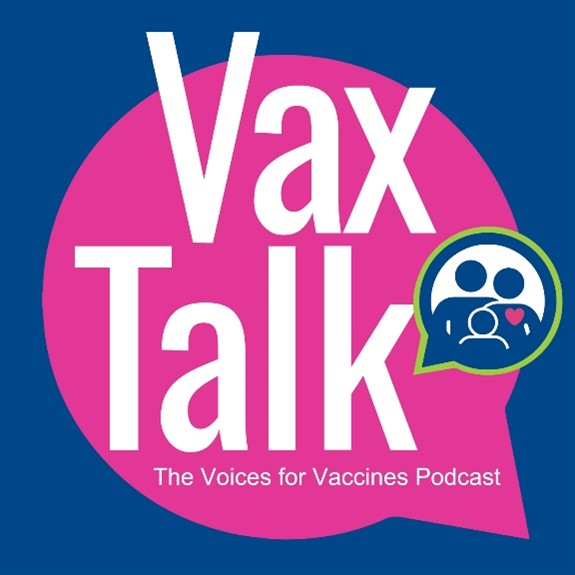
Announcements (continued)
Voices for Vaccines releases podcast with former CDC communications chief Glen Nowak on analyzing vaccine communication
Voices for Vaccines (VFV) posted a new entry in its Vax Talk podcast series: Vaccine Communication Breakdown featuring Glen Nowak, PhD, former CDC communications chief and risk-communication expert. A description from the VFV web page appears below.

In this episode, we break down vaccine communication, from the days of “Let the Science Speak for Itself” to the political partisanship of the pandemic.
Related Links

Spotlight: Immunize.org resources focused on influenza vaccination
Immunize.org offers many useful materials on influenza for healthcare professionals and caregivers.
Vaccines: Influenza main page is the one-stop shop for all of Immunize.org's available influenza resources for patients and staff. Important influenza-related resource links include handouts, Vaccine Information Statements (VISs), Ask the Experts popular questions and answers, state laws and mandates, standing order templates, and CDC immunization schedules.
Handouts: Influenza main page offers influenza-specific educational pieces for healthcare professionals and their patients. Check out Communicating the Benefits of Influenza Vaccination, one of Immunize.org's highly recommended handouts on discussing flu vaccination with patients.
Immunize.org also features a companion set to address misunderstandings about influenza vaccination: Not Sure If You Can Get an Influenza Vaccine? for patients and, for healthcare professionals, Talking with Your Patient about Contraindications and Precautions to Influenza Vaccination.
Vaccine Information Statement (VIS) documents are information sheets produced by CDC that explain both the benefits and risks of a vaccine to intended recipients. Translations are available in dozens of languages. Influenza VIS main pages include:
Ask the Experts: Influenza main page offers answers to influenza disease and vaccine-related questions as well as vaccine delivery guidance (e.g., administration, billing, documenting) from Immunize.org experts.
Every American household can once again order four free COVID-19 tests, delivered to their residence
Each United States household can now order one set of four at-home COVID-19 tests at COVID.gov/Tests. One order includes four individual rapid antigen COVID-19 tests that will ship at no charge.
The U.S. government will continue to make COVID-19 tests available to uninsured individuals and underserved communities through existing outreach programs. Please contact a HRSA health center, Test to Treat site, or Increasing Community Access to Testing (ICATT) for COVID-19 location near you to learn how to access low- or no-cost COVID-19 tests provided by the federal government.
Before you throw out "expired" tests, check FDA's website to see if your COVID-19 tests' expiration dates were extended.
2023-2024 Flu Season!
We are deep into flu season with low vaccination rates for influenza. A reminder to encourage everyone to obtain a flu vaccine if you are over 6 months in age.
Influenza Vaccination Dashboard
CDC's Weekly Flu Vaccination Dashboard shows the most recent data available on flu vaccine administration. Vaccine uptake appears to be lagging behind this time in 2022. Of note, coverage for all children is 4.1 percentage points lower this season compared with the same time last season (41.6% compared with 45.8%) and coverage for pregnant people is 2.1 percentage points lower (33.9% vs 36.0%).
Related Links
- CDC: Weekly National Flu Vaccination Dashboard main page
- CDC: FluView main page
- CDC: RESP-NET main page
- Immunize.org: free clinical resources and patient handouts related to influenza
- Immunize.org: Vaccines: Influenza main page
- Immunize.org: Ask the Experts: Influenza main page
- “Why Should Healthcare Professionals Focus on Vaccinating All Adults against Hepatitis B Now?”: watch the 2-minute answer, part of the Ask the Experts Video Series on Facebook, LinkedIn, X, YouTube, and Instagram
Questions about Simultaneous Vaccinations? Important Guidance from Ask the Experts
How many vaccines can be given during an office visit?
With rare exceptions*, all vaccines can be administered at the same visit. There is no upper limit for the number of vaccines that can be administered during one visit. ACIP and AAP consistently recommend that all needed vaccines be administered during an office visit. Vaccination should not be deferred because multiple vaccines are needed. All live vaccines (MMR, varicella, live attenuated influenza, yellow fever, and oral typhoid) can be given at the same visit if indicated. If live vaccines are not administered during the same visit, they should be separated by 4 weeks or more.
When giving several injections at a single visit, separate IM vaccines by at least 1 inch in the body of the muscle if possible to reduce the likelihood of local reactions overlapping. Here is a helpful site map for older children so you can record where shots were given:
For details see ACIP’s “General Best Practices Guidelines for Immunization”, available at www.cdc.gov/vaccines/hcp/acip-recs/general-recs/administration.html.
*There are 3 exceptions to this general rule: 1) if both pneumococcal conjugate vaccine (PCV13, Prevnar 13, Pfizer) and pneumococcal polysaccharide vaccine (PPSV23, Pneumovax 23, Merck) are indicated for a high-risk patient, these vaccines should not be given at the same visit. The PCV13 should be given first followed by PPSV23 at least 8 weeks later. If PPSV23 has already been given, wait 8 weeks (for a child) or 1 year (for an adult age 19 years or older) before giving PCV13 to avoid interference between the two vaccines. 2) A person with anatomic or functional asplenia or HIV should receive both PCV13 and meningococcal ACWY (MenACWY) vaccines. If Menactra brand (Sanofi) MenACWY is used, the person should first receive all recommended doses of PCV13 followed by Menactra at least 4 weeks later. Menveo (GSK) or MenQuadfi (Sanofi) MenACWY brands can be given at the same time or at any time before or after PCV13. 3) Cholera vaccine should be administered before TY21a vaccine, and 8 hours should separate cholera vaccine and the first dose of TY21a.